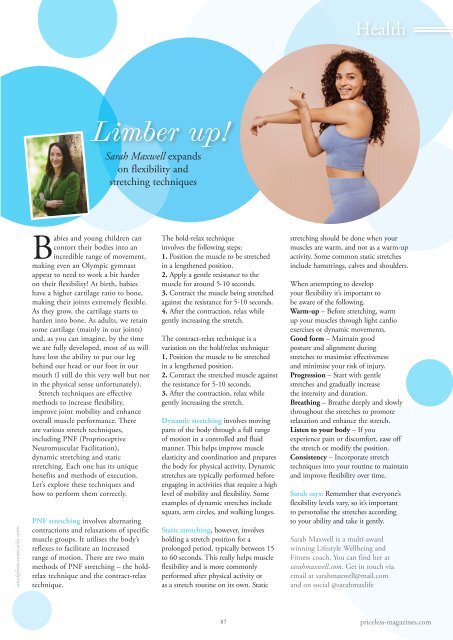Surrey Homes | SH110 | March 2024 | Kitchen & Bathroom Supplement inside
The lifestyle magazine for Surrey - Inspirational Interiors, Fabulous Fashion, Delicious Dishes
The lifestyle magazine for Surrey - Inspirational Interiors, Fabulous Fashion, Delicious Dishes
Create successful ePaper yourself
Turn your PDF publications into a flip-book with our unique Google optimized e-Paper software.
Health<br />
Limber up!<br />
Sarah Maxwell expands<br />
on flexibility and<br />
stretching techniques<br />
istockphoto.com/carles miro<br />
Babies and young children can<br />
contort their bodies into an<br />
incredible range of movement,<br />
making even an Olympic gymnast<br />
appear to need to work a bit harder<br />
on their flexibility! At birth, babies<br />
have a higher cartilage ratio to bone,<br />
making their joints extremely flexible.<br />
As they grow, the cartilage starts to<br />
harden into bone. As adults, we retain<br />
some cartilage (mainly in our joints)<br />
and, as you can imagine, by the time<br />
we are fully developed, most of us will<br />
have lost the ability to put our leg<br />
behind our head or our foot in our<br />
mouth (I still do this very well but not<br />
in the physical sense unfortunately).<br />
Stretch techniques are effective<br />
methods to increase flexibility,<br />
improve joint mobility and enhance<br />
overall muscle performance. There<br />
are various stretch techniques,<br />
including PNF (Proprioceptive<br />
Neuromuscular Facilitation),<br />
dynamic stretching and static<br />
stretching. Each one has its unique<br />
benefits and methods of execution.<br />
Let’s explore these techniques and<br />
how to perform them correctly.<br />
PNF stretching involves alternating<br />
contractions and relaxations of specific<br />
muscle groups. It utilises the body’s<br />
reflexes to facilitate an increased<br />
range of motion. There are two main<br />
methods of PNF stretching – the holdrelax<br />
technique and the contract-relax<br />
technique.<br />
The hold-relax technique<br />
involves the following steps:<br />
1. Position the muscle to be stretched<br />
in a lengthened position.<br />
2. Apply a gentle resistance to the<br />
muscle for around 5-10 seconds.<br />
3. Contract the muscle being stretched<br />
against the resistance for 5-10 seconds.<br />
4. After the contraction, relax while<br />
gently increasing the stretch.<br />
The contract-relax technique is a<br />
variation on the hold/relax technique<br />
1. Position the muscle to be stretched<br />
in a lengthened position.<br />
2. Contract the stretched muscle against<br />
the resistance for 5-10 seconds.<br />
3. After the contraction, relax while<br />
gently increasing the stretch.<br />
Dynamic stretching involves moving<br />
parts of the body through a full range<br />
of motion in a controlled and fluid<br />
manner. This helps improve muscle<br />
elasticity and coordination and prepares<br />
the body for physical activity. Dynamic<br />
stretches are typically performed before<br />
engaging in activities that require a high<br />
level of mobility and flexibility. Some<br />
examples of dynamic stretches include<br />
squats, arm circles, and walking lunges.<br />
Static stretching, however, involves<br />
holding a stretch position for a<br />
prolonged period, typically between 15<br />
to 60 seconds. This really helps muscle<br />
flexibility and is more commonly<br />
performed after physical activity or<br />
as a stretch routine on its own. Static<br />
stretching should be done when your<br />
muscles are warm, and not as a warm-up<br />
activity. Some common static stretches<br />
include hamstrings, calves and shoulders.<br />
When attempting to develop<br />
your flexibility it’s important to<br />
be aware of the following.<br />
Warm-up – Before stretching, warm<br />
up your muscles through light cardio<br />
exercises or dynamic movements.<br />
Good form – Maintain good<br />
posture and alignment during<br />
stretches to maximise effectiveness<br />
and minimise your risk of injury.<br />
Progression – Start with gentle<br />
stretches and gradually increase<br />
the intensity and duration.<br />
Breathing – Breathe deeply and slowly<br />
throughout the stretches to promote<br />
relaxation and enhance the stretch.<br />
Listen to your body – If you<br />
experience pain or discomfort, ease off<br />
the stretch or modify the position.<br />
Consistency – Incorporate stretch<br />
techniques into your routine to maintain<br />
and improve flexibility over time.<br />
Sarah says: Remember that everyone’s<br />
flexibility levels vary, so it’s important<br />
to personalise the stretches according<br />
to your ability and take it gently.<br />
Sarah Maxwell is a multi-award<br />
winning Lifestyle Wellbeing and<br />
Fitness coach. You can find her at<br />
sarahmaxwell.com. Get in touch via<br />
email at sarahmaxwell@mail.com<br />
and on social @sarahmaxlife<br />
87<br />
priceless-magazines.com

















